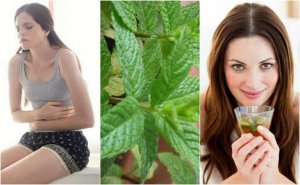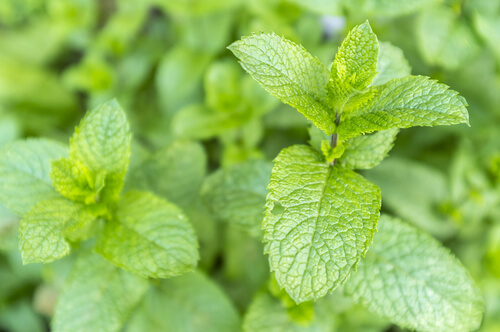5 Homemade Mint Remedies that You're Going to Love


Reviewed and approved by the doctor Maricela Jiménez López
Have you ever heard of mint remedies?
Mint is a plant that originates from Central Asia and the Mediterranean. Because of its properties, it’s been used in both gastronomy and medicine.
It’s characterized by its aroma and, also is valued for its high contents of digestive components, antispasmodics and antiseptics.
While it’s been used to give a special touch to some cocktails and recipes, it’s also a base ingredient in natural mint remedies. Both its extracts as well as its leaves and essential oils can be used in internal and external health treatments.
In fact, thanks to its sedatives, it works as a complement for treating stress and other emotional disorders that affect mental well-being.
Keeping in mind that many people don’t know its benefits, we’re going to share 5 remedies that you should take advantage of.
Take note!
1. Remedy to alleviate slow digestion

Because of its digestive, carminative and anti inflammatory properties, mint leaves are useful for treating slow digestion and excessive gas.
Its compounds optimize the decomposition process and the use of food that, at the same time, help get rid of waste through the intestines.
Ingredients
- 1 cup of water (250 ml)
- 1 tablespoon of mint leaves (10 g)
- 2 teaspoons of lemon juice (10 ml)
Preparation
- Boil the water and, when it starts to bubble, add the mint leaves.
- Cover it and let sit for 10 minutes.
- Then, filter it with a colander and add a tablespoon of lemon juice.
How to use
- Drink 2 or 3 glasses of the mint and lemon drink a day.
- Drink after eating very filling dishes.
2. Remedy for burns on your skin

The antioxidants, vitamins and minerals that are in mint leaves are ideal for promoting the regeneration process of the skin in the case of burns.
The plant’s natural oils are refresh the affected area, reducing irritation and burning.
Ingredients
- 1 tablespoon of fresh mint leaves (10 g)
- 2 teaspoons of water (10 ml)
- 1 tablespoon of honey (25 g)
Preparation
- Grind up the mint leaves in a mortar and, then, add them to the water with the tablespoon of honey.
How to use
- Spread the paste over the burned area and let sit for 15 minutes.
- Rinse and repeat 2 times a day.
3. Cough remedy

Ingredients
- 1 tablespoon of mint leaves (10 g)
- 1 cup of water (250 ml)
- 1/2 tablespoon of lemon juice (5 ml)
- 1 tablespoon of honey (25 g)
Preparation
- Add the mint leaves to the cup of boiling water and cover.
- Let the water sit for 10 minutes and then strain.
- Add the lemon juice and honey, stir.
How to use
- Drink the infusion on an empty stomach and repeat its consumption at noon and before going to bed.
- Drink the remedy until your cough is completely gone.
4. Remedy for calming stress

The calming components in mint leaves help to reduce stress symptoms and, over time, promote tiredness in case of insomnia.
In this case, we can improve its effects with other sedative plants. However, because of that, it’s best to only take it at night.
Ingredients
- 1 teaspoon of mint leaves (5 g)
- 1/2 tablespoon of linden flowers (5 g)
- 1/2 tablespoons of valerian (5 g)
- 1 cup of water (250 ml)
- 1 tablespoon of honey (25 g)
Preparation
- Add the plants to a cup of boiling water, cover and let sit for 10 minutes.
- After 10 minutes, strain the infusion and sweeten it with a tablespoon of honey.
How to use
- Drink the infusion 30 minutes before going to bed.
- Drink it 2 or 3 times a week.
5. Remedy for taking care of your liver

The digestive and anti inflammatory properties in mint leaves are combined with boldo to provide a complete treatment for protecting our liver.
These plants promote correct digestion of fats and, if that wasn’t enough, detox the hepatic tissues and gallbladder.
Ingredients
- 2 teaspoons of mint leaves (10 g)
- 1 tablespoon of dried boldo (10 g)
- 1 cup of water (250 ml)
Preparation
- Add the mint leaves and the boldo to a cup of boiling water.
- Cover the drink, let sit 10 minutes and strain.
How to use
- Drink a cup of the remedy on an empty stomach and, to get the best results, drink it again at noon.
- Drink for 2 or 3 weeks.
Did you already know about these uses for mint? Remember that, even though it’s healthy, you shouldn’t drink it if you’re pregnant or have high blood pressure.
All cited sources were thoroughly reviewed by our team to ensure their quality, reliability, currency, and validity. The bibliography of this article was considered reliable and of academic or scientific accuracy.
- Moloudizargari, M., Aghajanshakeri, S., Mikaili, P., & Mojaverrostami, S. (2013). Pharmacological and therapeutic effects of Mentha Longifolia L. and its main constituent, menthol. Ancient Science of Life. https://doi.org/10.4103/0257-7941.139059
- Tian, W., Akanda, M. R., Islam, A., Yang, H. D., Lee, S. C., Lee, J. H., … Park, B. Y. (2018). The anti-stress effect of mentha arvensis in immobilized rats. International Journal of Molecular Sciences. https://doi.org/10.3390/ijms19020355
- Mikaili P, Mojaverrostami S, Moloudizargari M, Aghajanshakeri S. Pharmacological and therapeutic effects of Mentha Longifolia L. and its main constituent, menthol. Anc Sci Life. 2013;33(2):131–138. doi:10.4103/0257-7941.139059
- Taneja, S. C., & Chandra, S. (2012). Mint. In Handbook of Herbs and Spices: Second Edition. https://doi.org/10.1533/9780857095671.366
- Lawrence, B. M. (2007). Mint The genus Mentha. CRC Press. https://doi.org/10.1007/s13398-014-0173-7.2
- Sazhina, N. N., Misin, V. M., & Korotkova, E. I. (2014). Antioxidant activity of mint. In Food Composition and Analysis: Methods and Strategies. https://doi.org/10.1201/b16843
- Sivropoulou, A., Kokkini, S., Lanaras, T., & Arsenakis, M. (1995). Antimicrobial Activity of Mint Essential Oils. Journal of Agricultural and Food Chemistry. https://doi.org/10.1021/jf00057a013
- Ben-Arye E, Dudai N, Eini A, Torem M, Schiff E, Rakover Y. Treatment of upper respiratory tract infections in primary care: a randomized study using aromatic herbs. Evid Based Complement Alternat Med. 2011;2011:690346. doi:10.1155/2011/690346
- McKay, D. L., & Blumberg, J. B. (2006). A review of the bioactivity and potential health benefits of peppermint tea (Mentha piperita L.). Phytotherapy Research. https://doi.org/10.1002/ptr.1936
- López, V., Martín, S., Gómez-Serranillos, M. P., Carretero, M. E., Jäger, A. K., & Calvo, M. I. (2010). Neuroprotective and neurochemical properties of mint extracts. Phytotherapy Research. https://doi.org/10.1002/ptr.3037
- Merat, S., Khalili, S., Mostajabi, P., Ghorbani, A., Ansari, R., & Malekzadeh, R. (2010). The effect of enteric-coated, delayed-release peppermint oil on irritable bowel syndrome. Digestive Diseases and Sciences. https://doi.org/10.1007/s10620-009-0854-9
This text is provided for informational purposes only and does not replace consultation with a professional. If in doubt, consult your specialist.








